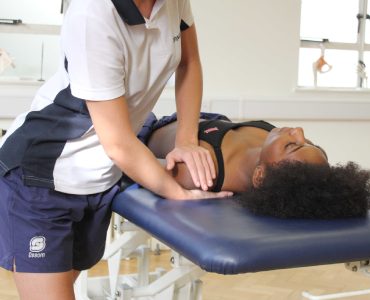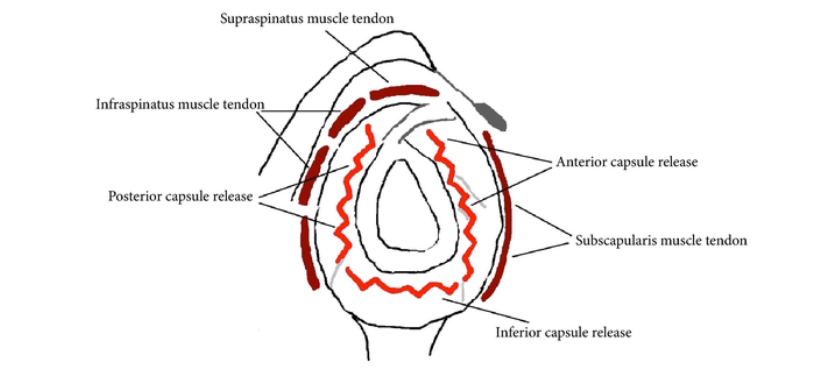Frozen Shoulder
Home / Frozen Shoulder
Frozen Shoulder
Get AppointmentWhat is a Frozen Shoulder?
Frozen shoulder is also known as adhesive capsulitis, peri-arthritis, and painful stiff shoulder. A frozen shoulder occurs as a result of limited movement of the shoulder (glenohumeral) joint. The joint is made up of a socket (the glenoid) and a ball (the humeral head).
Frozen shoulder affects the both active and passive range of motion – in other words, the movement of your shoulder is limited when you try to move your arm or when someone else tries to move your arm.
Frozen shoulder affects women more than men, usually between 50 to 60 years of age.
Frozen Shoulder Stages:
Freezing:
In the Freezing Stage, you slowly have more and more pain. As the pain worsens, your shoulder loses range of motion. Freezing typically lasts from 6 weeks to 9 months.
Frozen:
Painful symptoms may actually improve during this stage, but the stiffness remains. During the 4 to 6 months of the Frozen Stage, daily activities may be very difficult.
Thawing:
Shoulder Motion slowly improves during the Thawing Stage. Complete return to normal or close to normal strength and motion typically takes from 6 months to 2 years.
What causes a Frozen Shoulder?
Frozen shoulder can be broadly classified as
1. Primary Frozen Shoulder is also known as Idiopathic Adhesive Capsulitis. As the name suggests, no known cause can be identified in its pathogenesis. This is very commonly seen in Diabetics. Approximately, 30-35% of people with diabetes develop frozen shoulders at least once in their lifetime. Besides Diabetes, it is also commonly seen in people with Thyroid problems. Other rare associations include scleroderma, parkinsonism, rheumatoid arthritis, etc.
2. Secondary Frozen shoulder which develops whenever the shoulder is kept still for a long time, for example after fracture or shoulder surgery or even sometimes after a stroke or heart surgery. This is less common when compared with primary frozen shoulder
How is a Frozen Shoulder Diagnosed?
Though diagnosis is mostly clinical, following investigations help in differentiating pain in the shoulder due to a frozen shoulder vs other conditions like rotator cuff tendinosis, etc.
- ULTRASONOGRAPHY – Emerging as the investigation of choice as it’s faster and easier to perform. Thickening of the coracohumeral ligament and its adhesions to long heads of the biceps is the diagnostic hallmark. However, ultrasound is very much operator-dependent and the efficacy depends on the skill and knowledge of the person performing the ultrasound. This limits its role

MRI – More resource-intensive than ultrasound but it benefits with less intra-observer variability. Loss of axillary recess is the hallmark of adhesive capsulitis
X-Rays – No role except in identifying other causes that can mimic as adhesive capsulitis such as minor fractures etc.
Treatment of Frozen Shoulder
In many cases, Frozen Shoulder improves over time with or without treatment. However, treatment can help manage the pain better, relieve other symptoms and speed up the healing process.
Non-Steroidal Anti-Inflammatory Drugs (NSAIDs)
In mild cases, non-steroidal drugs are prescribed to reduce pain and swelling.
Physical Therapy
A customized physiotherapy program will be charted out depending on your condition. Regular physical therapy has helped most of the patients gain arm motion and recover from Frozen Shoulders.
Steroid Injections
In severe cases, where non-steroid medications do not help relieve the pain and the patient is unable to perform physiotherapy – Steroid injections are given to reduce pain and inflammation.
Surgery and Procedures
Shoulder Arthroscopy
If all the non-surgical conservative treatment fails to relieve the pain and symptoms, your Shoulder Doctor will recommend Shoulder Arthroscopy in selected cases. This procedure is designed to increase the range of motion and improve shoulder movement.
Manipulation under anaesthesia
In this procedure, the doctor provides the patient with anaesthesia and then forces the shoulder to move in several directions. This cuts and tears the scar tissues thus enabling increased motion of the shoulder.
Recovery and Rehabilitation after a Shoulder Therapy/Surgery
Physical therapy is necessary after surgery. Commitment to regular physical therapy has helped most of the patients recover completely from Frozen Shoulder and its symptoms.

GET APPOINTMENT
Schedule Appointment : Your Path to Specialized Care
Get rid of your pain, stress, and enduring with our 24/7 dental services. It's a priority to relieve the pain in surgeon as much as possible. 90% of customers claim that they would come back & recommend us to others.
